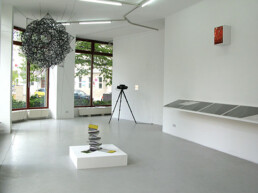The Redistribution of the Sensible (2007)
Magnus Müller, Berlin (DE)
Curated by Warren Neidich
April 13 – May 26, 2007

Participating artists include Eric Anglès, Matthew Antezzo, Pash Buzari, Krysten Cunningham, Olafur Eliasson, Liam Gillick, Ján Mančuška, Yudi Noor, Tomás Saraceno, Erik Smith, Nora Schultz and Jordan Wolfson.
Occasionally translated as “the partition of the sensible,” [distribution of the sensible] le partage du sensible refers to the implicit law governing the sensible order that parcels out places and forms of participation in a common world by first establishing the modes of perception within which these are inscribed. The distribution of the sensible thus produces a system of self-evident facts of perception based on the set horizons and modalities of what is visible and audible as well as what can be said, thought, made or done. Strictly speaking, “distribution” therefore refers both to forms of inclusion and to forms of exclusion. The “sensible” of course, does not refer to what shows good sense or judgment but to what is aistheton or capable of being apprehended by the senses.
—from Appendix I, The Politics of Aesthetics by Jacques Rancière1
However, today’s high-tech knowledge-based society organizes this distribution with sophisticated apparati that are reminiscent of the “society of control” expressed in Michael Hardt and Antonio Negri’s Empire.2 The logics of perception and experience are no longer materialistically defined only by contours of geometric and linear time and space arranged hierarchically in a rigid lattice, but rather follow curved, nonlinear Riemannian paradigms that are expressed in complicated, non-hierarchical, rhizomatic, shifting patterns. Consider, for example, the way commodities are now linked together as branded networks that intensify their desire quotient, or how people communicate in chat rooms or move in and out of blog sites. Utilizing these methods and those of the global marketplace (with the help of the continuing scientific research on perception and cognition), a new sovereignty has conspired in creating powerful complex networks of attention that allow for the manufacture of artificial “connectedness” that today defines the distribution of the sensible.
Phatic images, as defined by Paul Virilio, have evolved into highly attention-grabbing conglomerates of stimuli that act as multiplicities and operate beyond the sensorium, reaching into the folded gyri and sulci of the brain itself.3 These networks form a hegemonic cultural syntax that is inscribed en masse on society as a whole, producing new forms of subjectivity and, in the case of the world tuned into global media, a bounded multitude. When these networks are internalized and become part of the automatic operation of the body or mind’s habitual relationships, they form a society of control rather than a disciplinary society. (Self-censorship is a perfect example of the society of control and how insidiously this process becomes self-evident.) These images together produce “institutional understanding,” the framework through which most of us operate in the real world of material things. When these networks are internalized and part of the automated action of the body and mind, they form a control society—not a disciplinary society.
However, artists also create their own distribution of the sensible. They use their own historical referents, materials, processes, apparati, spaces, and performances to create complex assemblages that together compete with institutional arrangements for the attention of the brain and mind. Their artistic imaginations produce practices that allow for the exploration of remote territories—like the paranormal, nonlinear, psychic, and insensible—which pulsate beyond the reach of the formulaic methodologies of the philosopher’s logic and the scientist’s experimental design. However, this does not imply that art is disengaged and distanced from life as some form of hermetic endeavor, but quite the opposite. It is embedded in the interwoven fabric of social, political, economic, psychological, historical, and spiritual relations. In fact, it commingles with life and complex systems of recurrent and recursive loopings that ultimately help to help produce novel networks that empower the imagination of each receptive subject with new possibilities—which, in the end, reconstitute the cultural landscape with new objects, object relations, contexts, and arrangements. These loopings inhabit the same spaces and temporalities as the institutional orders that characterize the institutional understanding. Their presence, however, acts to bend and contort it, in the end, altering its static and rigid arrangements in significant ways.
Works like installation art, performative sculpture, and urban geographies aim to re-establish the laws of the sensual world, while conceptually-based works, relational aesthetics, and institutional critique operate on more a metaphorical level by incorporating meaning, contexts, and critiques in order to influence the reading, understanding and course of the sensory experience. For instance, Situationists taught us to understand urban space kinesthetically in relation to origin and return (through the dérive and détournement), taking into account what before was uninteresting and insignificant, and to proceed in a way that allows us to understand the significance of urban sprawl in the grand conceptual schema of the meaning of contemporary life. (Of course, the institutional understanding is always attempting to co-opt Situationist methods, terminology, and processes.)
The Redistribution of the Sensible investigated some contemporary art practices that are addressing these issues.












